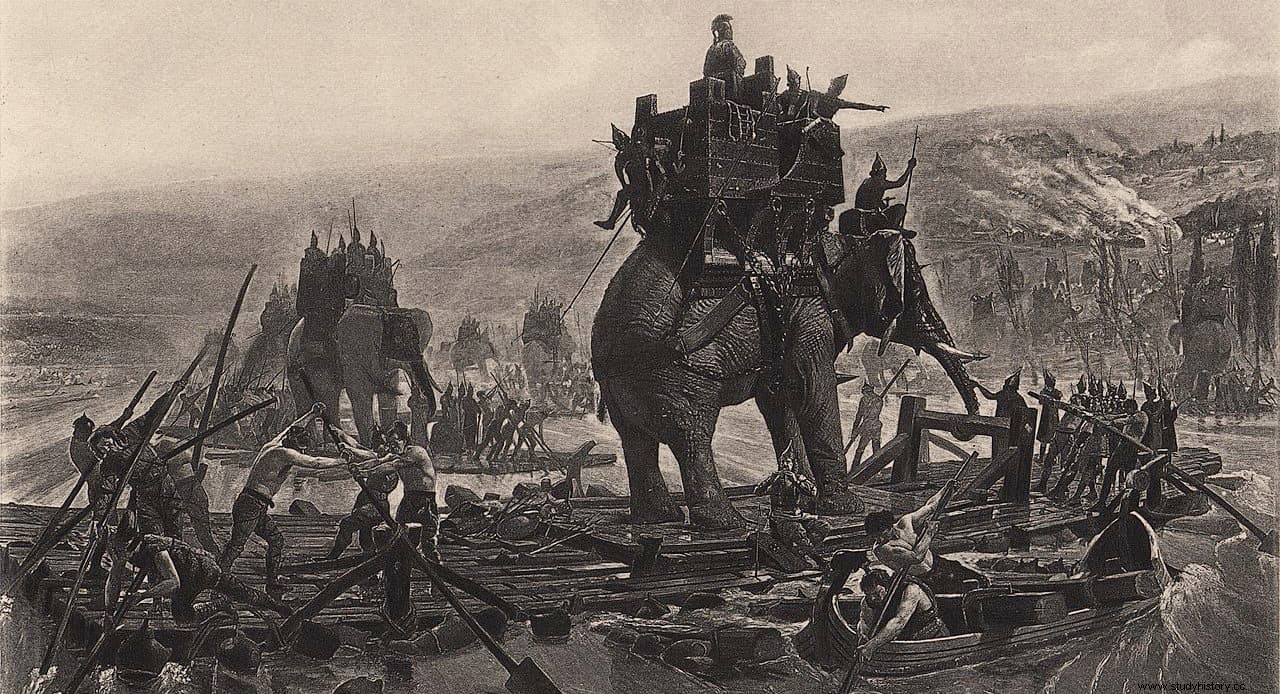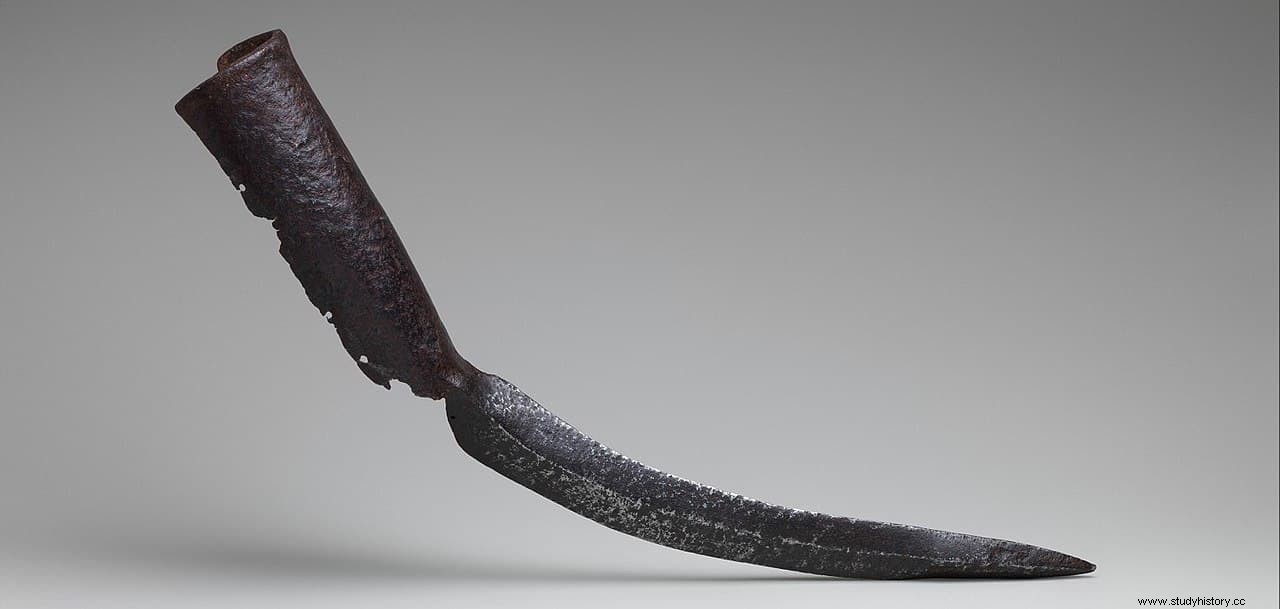If Man has never had too many scruples to make mincemeat of his neighbor in wars, better luck could not be expected for the animals at his service.
Dogs, horses, pigeons, bees and pack animals, for example, have participated in the pandemonium of war, just as dolphins have recently joined.
But in ancient times there was a very special species that formed a fundamental part of the armies of some peoples, such as the Indian or the Carthaginian:I am referring to the elephant , authentic living tank. The sight of a line of these creatures must have been overwhelming, because warrior accessories used to be added to the size, such as armor to protect it, blades set in the fangs or chains in the trunk.

It was necessary to pull the imagination to stop the advance of such a formidable adversary and the answer, say some classics, was found in yet another animal, this one even more unheard of:the pig .
It is true that the stories are somewhat vague or vague, sometimes even divergent, when it comes to giving their version. Because, according to what they say, it was the grunts of these animals that caused panic in the pachyderms, causing them to break formation and get out of hand, sowing chaos among their own hosts.
What happens is that there are chronicles that further specify the way in which the pigs were forced to scream:by setting them on fire and whipping them into enemy lines, which is supposed to require special tuning to make them all catch fire at the same time and run in the right direction at the right time (a living being can only move engulfed in flames for a very long time). limited).
It is difficult to establish to what extent the historical references are real. to the use of this singular porcine weapon, but the truth is that there are a few and, in addition, some located in important battles. In his De rerum natura , Lucretius He reviews the use of non-domestic beasts as early as the 1st century, although he mentions lions and wild boars.

Of the lions we know that there is news before; for example, the one that attributes to Ramses II the possession of one as a pet, which would have fought alongside him in Kadesh against the Hittites.
Pliny the Elder he says in his Naturalis Historia (a kind of encyclopedia in thirty-seven books that deals with diverse topics such as geography, astronomy, botany, medicine, geology and zoology that began to be published in the year 77 AD) that elephants are scared by the screeching of the pig, an assertion that confirms Claudio Eliano in De Natura Animalium , extending this frightening effect to rams and explaining that the Romans used both species to confront Pyrrhus's proboscideans in the year 275 BC
Pyrrhus, king of Epirus (a region in western Greece that today is located partly in this country and partly in Albania) and -briefly- of Macedonia, had moved to the Italian peninsula with a powerful army of twenty thousand infantry, three thousand riders and half a hundred elephants , to confront the expansionist power of Rome with the help of the Tarentines and other peoples who feared falling under the Roman yoke.
We are not going to recount the entire campaign here; we will simply refer to the final confrontation in the battle of Malaventum (also known as Benevento). The Epirote phalanxes and the Roman legions engaged in an even battle in which neither formation seemed capable of breaking the opposing formation , so Pyrrhus decided to give it a try by sending the elephants towards a Roman flank.
But the consul Dentatus had foreseen this contingency, preparing an unusual countermeasure:a herd of pigs smeared with oil whom he set on fire and threw against the enemy colossi causing terror among them. The classical version gives the Roman archers the real credit for using incendiary arrows against the gigantic animals; In any case, it does seem certain that they sowed chaos among their own lines and only at the cost of great efforts was it possible to dominate them, being withdrawn to the rear to avoid greater harm. The end result:two specimens died and eight were captured.
However, the use of the pig to scare the elephant would be much earlier chronologically if we look at the so-called Romance de Alejandro , a collection of Greek legends that gloss the exploits of the Macedonian hero and that are erroneously attributed to the Greek historian Callisthenes, since this author could only write a part of the work and the rest is a compilation of the third century (hence it is usually speak rather of Pseudo-Callisthenes).
Another Macedonian, Polyene , wrote a military treatise in eight books entitled Strateges in which he tells how in the year 266 B.C. Citizens of besieged Megara set fire to pigs smeared with resin and they launched them against the enemy pachyderms of King Antigonus II Gonatas, sowing confusion and causing them to turn against their masters. The case of Polieno is especially interesting in this regard, since this author presumed to tell only authentic facts , with didactic intention.

Halfway between Antiquity and the Middle Ages, the reviews continued. Procopius of Caesarea , a sixth-century Byzantine historian, recounted another case, this one without flames, in his History of Wars :The defenders of Edessa, another encircled city, lowered a pig over the walls tied with a rope so that its screams would scare away a pachyderm that the besiegers used in siege work. That of Procopio is also a story to take into account, since he was secretary of the famous general Belisario and, as such, he personally assisted in his campaigns against the Sassanids, Vandals, and Ostrogoths.
However, the use of pigs for weapons, with or without fire, was limited and was doomed to disappear at the same time that the use of war elephants did.
This was only testimonial from the Middle Ages onwards and so on, although it is known that Charlemagne he had one (which he took with him on his campaign through Denmark), as did Frederick II Hohenstaufen (who used it on the Cremona site), were more anecdotal than anything else.
In Asia alone, elephants continued to form part of the armies and there were a hundred of them that the Indians They opposed the advance of Tamerlane in 1398, who put them to flight with a variant of the porcine weapon:he ordered bales of straw to be loaded on camels , he set them on fire and spurred them into the enemy lines; another version says that the simple smell of camels, unknown to the proboscideans, was enough. Same background for different shapes.
